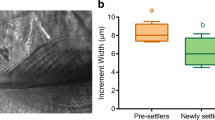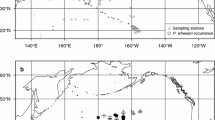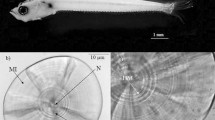Abstract
The significance of hatch date for the growth and survival of the sandeel,Ammodytes marinus, was investigated using otolith microstructure. Hatch dates of 2 to 6 mo-old juvenileA. marinus caught near Shetland were compared between 1990 and 1992, during which period year-class strength varied by more than an order of magnitude. The hatch-date distribution of juveniles in the 1992 year-class was compared with that estimated directly from the abundance of newly emerged larvae on the spawning grounds. The extent of larval hatching periods in 1990 and 1991 was also estimated from continuous plankton-recorder data. There were significant differences in hatching periods between all three years, hatching in 1990 and 1992 being markedly earlier than the long-term mean peak in hatching indicated from archival data. Most individuals from the 1991 year-class attained a larger size by July than those in other year-classes, despite hatching later. Variation in individual growth rates both within and between year-classes indicated that there was a seasonal cycle of growth opportunity in all years investigated. The study suggests that the degree of coupling between hatching and the onset of spring secondary production may be an important contributory factor to year-class variability in this species.
Similar content being viewed by others
References
Anonymous (1994) Report of the working group on Norway pout and sandeels. Int Counc Explor Sea Comm Meet (1994/Assessment) 14: 1–94
Berntsen J, Skagen DW, Svendsen E (1994) Modelling the transport of particles in the North Sea with reference to sandeel larvae. Fish Oceanogr 3: 81–91
Bollens SM, Frost BW, Schwaninger HR, Davis CS, Way KJ, Landsteiner MC (1992) Seasonal plankton cycles in a temperate fjord and comments on the match-mismatch hypothesis. J Plankton Res 14: 1279–1305
Bowman A (1914) The spawning areas of sandeels in the North Sea. Scient Invest Fishery Bd Scotl 1913(3): 1–13
Buckley LJ, Halavik TA, Smigielski AS, Laurence GC (1987) Growth and survival of the larvae of three species of temperate marine fishes reared at discrete prey densities. Am Fish Soc Symp 2: 82–92
Buckley LJ, Turner SI, Halavik TA, Smigielski AS, Drew SM, Laurence GC (1984) Effects of temperature and food availability on growth, survival and RNA-DNA ratio of larval sandeel lance (Ammodytes americanus). Mar Ecol Prog Ser 15: 91–97
Campana SE, Jones CM (1992) Analysis of otolith microstructure data. Can Spec Publ Fish aquat Sciences 117: 73–100
Canino MF, Bailey KM, Incze LS (1991) Temporal and geographic differences in feeding and nutritional condition of walleye pollock larvaeTheragra chalcogramma in Sheilkof Strait, Gulf of Alaska. Mar Ecol Prog Ser 79: 27–35
Coombes SH (1980) Continuous plankton records: a plankton atlas of the North Atlantic and North Sea. Bull mar Ecol 229–281
Coull KA, Jermy AS, Newton AW, Henderson GI, Hall WB (1989) Length/weight relationships for 88 species of fish encountered in the north east Atlantic. Scott Fish Res Rep 43: 1–81
Cury P, Roy C (1989) Optimal environmental window and pelagic fish recruitment success in upwelling areas. Can J Fish aquat Sciences 46: 670–680
Cushing DH (1975) Marine ecology and fisheries. Cambridge University Press, Cambridge and New York
Cushing DH (1990) Plankton production and year-class strength in fish populations: an update of the match/mismatch hypothesis. Adv mar Biol 26: 249–293
Economou AN (1991) Food and feeding ecology of five gadoid larvae in the northern North Sea. J Cons int Explor Mer 47: 339–351
Fortier L, Ponton D, Gilbert M (1995) The match/mismatch hypothesis and the feeding success of fish larvae in icecovered southeastern Hudson Bay. Mar Ecol Prog Ser 120: 11–27
Fossum P, Moksness E (1993) A study of spring-and autumnspawned herring (Clupea harengus L.) larvae in the Norwegian coastal current during spring 1990. Fish Oceanogr 2: 73–81
Fransz HG, Colebrook JM, Gamble JC, Krause M (1991) The zooplankton of the North Sea. Neth J Sea Res 28: 1–52
Fujiwara T, Nakata H, Tanda M, Karakawa J (1990) Biological and physical parameters of the population dynamics of sandeel larvae in the eastern Seto Inland Sea. Nippon Suisan Gakk 56: 1029–1037
Gauld JA, Hutcheon JR (1990) Spawning and fecundity in the lesser sandeel,Ammodytes marinus Raitt, in the north-western North Sea. J Fish Biol 36: 611–613
Gilbert M, Fortier L, Ponton D, Drolet R (1992) Feeding ecology of marine fish larvae across the Great Whale River plume in seasonally ice-covered south eastern Hudson Bay. Mar Ecol Prog Ser 84: 19–30
Hart PJB (1974) The distribution and long-term changes in abundance of larvalAmmodytes marinus (Raitt) in the North Sea. In: The early life history of fish. Blaxter JHS (ed) Springer-Verlag, Berlin, pp 171–182
Hay SJ, Kiorboe T, Matthews A (1991) Zooplankton biomass and production in the North Sea during the autumn circulation experiment, October 1987-March 1988. Contin Shelf Res 11: 44–57
Heath MR (1992) Field investigations of the early life stages of marine fish. Adv mar Biol 28: 2–133
Henderson GTD (1961) Contribution towards a plankton atlas of the north-eastern Atlantic and the North Sea. Part V. Young fish. Bull mar Ecol 5: 105–111
Houde ED (1989a) Comparative growth, mortality, and energetics of marine fish larve: temperature and implied latitudinal effects. Fish Bull US 87: 471–495
Houde ED (1989b) Subtleties and episodes in the early life of fishes. J Fish Biol 35 (Suppl A): 29–38
Inoue A, Takamori S, Kuniyuki K, Kobayashi S, Nishina S (1967) Studies on the fishery biology of the sand-lance,Ammodytes personatus (Girard). Bull Naikai reg Fish Res Lab 25: 1–335
Kimura S, Kishi MJ, Nakata H, Yamashita TY (1992) A numerical analysis of population dynamics of the sand lance (Ammodytes personatus) in the eastern Seto Inland Sea, Japan. Fish Oceanogr 1: 321–332
Kunzlik PA, Gauld JA, Hutcheon JR (1986) Preliminary results of the Scottish sandeel tagging project. Int Counc Explor Sea Comm Meet (Demersal Fish Comm) 1986/G:7: 1–8
Langham LPE (1971) The distribution and abundance of larval sand-eels (Ammodytidae) in Scottish waters. J mar biol Ass UK 51: 697–707
MacDonald PDM, Pitcher TJ (1979) Age-groups from size-frequency data: a vesatile and efficient method of analysing distribution mixtures. J Fish Res Bd Can 36: 987–1001
Macer CT (1965) The distribution of larval sandeels (Ammodytidae) in the southern North Sea. J mar biol Ass UK 45: 187–207
MacKenzie BR, Leggett WC, Peters RH (1990) Estimating larval fish ingestion rates: can laboratory-derived values be reliably extrapolated to the field? Mar Ecol Prog Ser 67: 209–225
McGurk MD, Warburton HD (1992) Pacific sand lance of the Port Moller estuary, southeastern Bering Sea: an estuarine-dependent early life history. Fish Oceanogr 1: 306–320
McGurk MD, Warburton HD, Galbraith M, Kusser WC (1992) RNA-DNA ratio of herring and sand lance larvae from Port Moller, Alaska: comparison with prey concentration and temperature. Fish Oceanogr 1: 193–207
Method RD (1983) Seasonal variation in survival of larval northern anchovy.Engraulis mordax, estimated from the age distributions of juveniles. Fish Bull US 81: 741–750
Methot RD (1986) Frame trawl for sampling pelagic-juvenile fish. Rep Calif coop ocean Fish Invest (CalCOFI) 27: 267–278
Moksness E, Fossum P (1992) Daily growth rate and hatching-date distribution of Norwegian spring-spawning herring (Clupea harengus L.). JCES J mar Sci 49: 217–221
Monteleone DM, Peterson WT (1986) Feeding ecology of American sand lanceAmmodytes americanus larvae from Long Island Sound. Mar Ecol Prog Ser 30: 133–143
Pepin P (1991) The effect of temperature and size on development, mortality and survival rates of pelagic early life history stages of marine fish. Can J Fish aquat Sciences 48: 1820–1828
Ricker WE (1979) Growth rates and models. In: Fish physiology. Vol 8. Hoar WS, Randall DJ, Brett JR (eds) Academic Press, New York, pp 677–743
Rothschild BJ (1986) Dynamics of marine fish populations. Harvard University Press, Cambridge, Mass
Ryland JS (1964) The feeding of plaice and sandeel larvae in the southern North Sea. J mar biol Ass UK 44: 343–364
Sherman K, Smith W, Morse W, Berman M, Green J, Ejsymont L (1984) Spawning strategies of fishes in relation to circulation, phytoplankton production, and pulses in zooplankton off the northeastern United States. Mar Ecol Prog Ser 18: 1–19
Sinclair M (1988) Marine populations: an essay on population regulation and speciation. University of Washinton Press, Seattle, Washington
Sinclair M, Tremblay MJ (1984) Timing of spawning of Atlantic herring (Clupea harengus harengus) populations and the match-mismatch theory. Can J Fish aquat Sciences 41: 1055–1065
Smigielski AS, Halavik TA, Buckley LJ, Drew SW, Laurence GC (1984) Spawning, embryo development and growth of the American sand lanceAmmodytes americanus in the laboratory. Mar Ecol prog Ser 14: 287–292
Sundby S, Fossum P (1990) Feeding conditions of north-east Arctic larvae compared to the Rothschild-Osborn theory on smallscale turbulence plankton. J Plankton Res 12: 1153–1162
Turrell WR (1992) The East Shetland Atlantic inflow. In: Dickson RR, Mäikkl P, Radach G, Sætre R, Sissenwine MP (eds) Hydrobiological variability in the ICES area, 1980–1989. ICES Marine Science Symposium No. 195. International Council for the Exploration of the Sea, Copenhagen, pp 127–143
Turrell WR, Henderson EW, Slesser G, Payne R, Adams RD (1991) Seasonal changes in the circulation of the northern North Sea. Contin Shelf Res 12: 257–286
Winslade P (1971). Behavioural and embryological studies on the lesser sandeelAmmodytes marinus (Raitt). PhD thesis, University of East Anglia, England
Wright PJ (1993) Otolith microstructure of the lesser sandeel,Ammodytes marinus. J mar biol ass UK 73: 245–248
Wright PJ (1993) Is there a conflict between sandeel fisheries and seabirds? A case study at Shetland. In: Greenstreet SPR, Tasker M (eds) Aquatic predators and their prey. Blackwell Scientific Publications, Oxford
Yamashita Y, Aoyama T (1986) Starvation resistance of larvae of the Japanese sand eelAmmodytes personatus. Bull Jap Soc Scient Fish 52: 635–639
Author information
Authors and Affiliations
Additional information
Communicated by J. P. Thorpe, Port Erin
Rights and permissions
About this article
Cite this article
Wright, P.J., Bailey, M.C. Timing of hatching inAmmodytes marinus from Shetland waters and its significance to early growth and survivorship. Mar. Biol. 126, 143–152 (1996). https://doi.org/10.1007/BF00571386
Received:
Accepted:
Issue Date:
DOI: https://doi.org/10.1007/BF00571386




